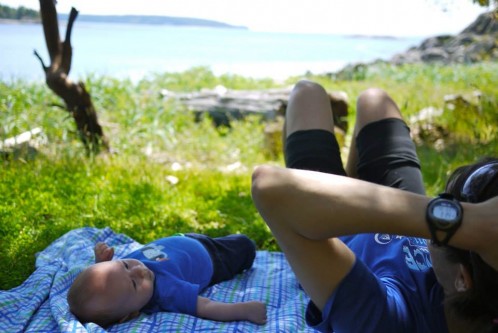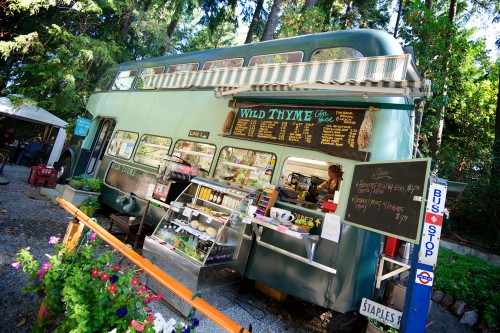We faced our share of doubters when we decided to load up our beloved truck camper, newborn son Roger included, and do a road trip. But honestly, this kind of naysaying just spurs me on. Stubbornly, we packed our bags and made a plan.
Together, along with our family dog, we would explore as much of B.C.’s Gulf Islands archipelago as we could. Our trip would be a homecoming of sorts – but also a new adventure for us given that a 10-pound human being would dictate the pace.
Eight years ago, work lured me away from my childhood home on Vancouver Island to Calgary. “Two years,” I said. “I’ll give myself two years before heading home.” Then life happened. I made a network of friends, met my now-wife (Devon), bought a house and, just a few months ago, had a son.
We decided to spend the last weeks of my three-month paternity leave exploring Canada’s West Coast.
GALIANO ISLAND
We arrive in Tsawwassen, B.C., the mainland’s primary ferry terminal south of Vancouver, and I know I’m home given the sweet tang of sea that fills my nostrils.
We board what locals dub “the milk run” which zig-zags its way through the southern Gulf Islands, picking up and dropping off passengers along the way.
First stop? Galiano Island. Although the weather is generally gorgeous and the island is a mere three hours from downtown Vancouver, its sparse accommodation options and limited number of campsites seem to keep the hordes at bay.
While the huge metropolis of Vancouver stares unblinkingly at us from across Georgia Strait, the warmth of Galiano’s islanders shines.
Anyone we stop to say hello to launches into a half-hour conversation about island life.
On a visit to local glass artist Marcia Devicque’s studio – where orange and blue light refract off the handcrafted art and into the forest canopy above – we chat about her choice to leave the relative bustle of Victoria in pursuit of a quiet, artist’s life.
Marcia points us to the commanding views of Bodega Ridge and the long, meandering path that makes its way down to the secluded Pebble Beach (the perfect skinny-dipping spot.)
Devon and I are seasoned travellers but bringing along the littlest of campers definitely changes the pace. We find that a nursing baby is highly portable, if his needs are met. And after a few days, we begin to find our new groove.
Tinfoil over the windows in one section of our camper helps Roger fall asleep and lets us hang out, read and play Scrabble (almost, we laugh, like in our pre-parenting days) before dozing off ourselves.
And so we zig and we zag on Roger’s own private milk run through the islands.
Feed, diaper, hike. Feed, diaper, artisan visit. Feed, diaper, make dinner.
SATURNA ISLAND
Heavy dollops of rain twang a West Coast melody on our camper roof the morning we leave for Saturna Island.
Playing it safe, we arrive at the ferry terminal with plenty of time to spare in case the ferry is full. Instead, a first for me: we are the only vehicle aboard. The ferry crew joke that most billionaires don’t have personal yachts this big. Then they retreat from the rain, leaving us alone in our camper on the open car deck.
This is a great precursor to three days of sweet solitude. With a population of just 300, Saturna is known for its quiet remove. Almost half of the island is park land, and hikes to Narvaez Bay, Echo Bay and Taylor Point are all breathtaking and serene. We never see a soul on any of these outings.
Saturna offers a step back in time on the Gulf Islands: every car you pass gives a wave; the art galleries have no set schedule; feral goats traipse the woods; the school has two students.
Seeing a new, young family, the folks at the Wild Thyme Coffee House – a vintage double-decker bus that’s been renovated to serve up amazing food, bakery treats (try the blackberry pie when it’s in season) and locally roasted coffee – recruit us to move here.
Babies, it turns out, are not the hindrance to travel that some would have you believe. Instead, they’re a natural icebreaker that thaw the hearts of even the most tourist-averse locals.
Roger’s freshly learned smile also garners us loads of insider tips—like Saturna beach being the best spot on the island for sunset viewing, and the community centre being a great option for campers in search of a cheap shower.
An entrepreneurial spirit lives on Saturna. A vineyard, a well-stocked grocery store and marvellous dining options are not things I would’ve anticipated.
But, besides the eight walk-in tenting spots in Narvaez Bay, there is nowhere else to camp. So we have to get creative, parking our truck camper in roadside pullouts for the night.
Feed, diaper, sleep.
SALTSPRING ISLAND
We leave the sleepy solitude of Saturna when we ferry over to Saltspring Island – what some call the “Hollywood of the Gulf Islands.”
Perhaps the best known of the islands, Saltspring’s population balloons from 10,000 in winter to 30,000 in summer. There’s even a rush hour and public transit.
We opt for quiet hikes through Ruckle Provincial Park and up to the stunning viewpoints atop Mount Maxwell.
Two-month-old Roger proves to be the perfect hiking companion. With a baby carrier strapped to my front, we hop over logs, through rocky terrain and up steep trails with ease. And the more moderate temperatures of our shoulder-season visit mean that Roger isn’t overheating, either.
As we explore, our son is rocked into one of the many naps an infant needs. Hiking and napping babies seem to go hand in hand.
Feed, diaper, hike.
CORTES ISLAND
After Saltspring, we ponder heading to Hornby Island for a bit of the old-fashioned hippie vibe. As a kid, I grew up travelling to Hornby Island each summer, and seared in my memory are the weekly “topless days” at the island co-op store where men and women alike could shop without the encumbrances of shirt or bra. Unforgettable.
Thirty years later, things have changed on Hornby, too. And while it’s a place I still love to visit for its beaches, mountain biking and vivid childhood memories, this time around we decide to forego the familiar for the unknown.
So we beeline it to Cortes Island, located a little further north, via Campbell River, a small city on the east coast of Vancouver Island.
We immediately fall in love with the place. Perhaps because it’s just that much further removed, Cortes has managed to hold onto the vibe of the Hornby of my childhood.
Beaten-up pickup trucks sputter and bang their way down deserted roads to spectacular sandy beaches, lagoons and coves.
The ocean waters in this area are the warmest on the B.C. coast and, especially on hot summer days, a dip into the Pacific is delicious. Roger and our dog watch from the sandy shore as Devon and I take turns wading into the waters of Smelt Bay, Manson’s Landing and Hank’s Beach.
There’s even a white-sand beach on fresh-water Hague Lake if you want to wash away some of that salty grime at the end of the day.
After five days, we are truly sad to leave Cortes. The population of around 1,000 full-time residents is extremely tight-knit but also the most welcoming we come across.
Our long conversations with oyster fishermen at the end of a shift or retired musicians jamming on sandy beaches make it feel like we are leaving an island chock with old friends.
Feed, diaper, swim.
POWELL RIVER
Our final part of the journey isn’t intended. We ferry from Comox on Vancouver Island to Powell River on the mainland so that we can catch yet another ferry to Texada Island.
Texada is the largest of the northern Gulf Islands but little visited. As it turns out, the ferry to it breaks down just hours before our departure and we are left instead to explore Powell River.
This community is located on the mainland’s Sunshine Coast but there are no roads linking it to Vancouver. So, in many ways, it is like its own isolated island.
It’s also a hiker’s dream. Over the last 22 years, a group of committed locals took on an ambitious project: to build the 180-kilometre Sunshine Coast Trail. The trail weaves its way through lush forest, alpine meadows and down to hidden shorelines with huts that multi-day hikers can stay in for free. It’s a hidden gem that only sees around 600 hikers a year.
We spend one day hiking to the summit of Mount Troubridge. At 1300 metres, it’s the highest point on the Sunshine Coast Trail and the view is absolutely breathtaking: the snowcapped Coast Mountains rocket up to the east and the peaks of Vancouver Island flank us to the west.
It isn’t always easy spending a month in the cramped confines of a camper. There are tough nights trying to put Roger to bed, long stretches without a shower, and adventures like getting stuck in the mud on an old dirt road we probably shouldn’t have gone down in the first place.
Travelling with a child is a whole new planet for us. But we’ve seen so much over the course of a month.
And on the last leg of our journey, from our perch on Troubridge – where far below, floating in the cool navy-blue ocean, the Gulf Islands spread north and south to the horizon – it’s clear how much there still is to discover. Our adventures with Roger have just begun.
Feed, diaper, explore.
Editor’s note: Many thanks to Vancouver Island Tourism, Vancouver Coast and Mountains Tourism, BC Ferries and Destination BC for helping support Paul’s trip. And to Paul, as well – author of earlier Toque & Canoe posts School of Powder: Boot Camp for Big Mountain Skiers and Into the Frozen Yukon Wild: A winter snapshot of Canada’s smallest territory. This post was not edited or reviewed by our partners in tourism before publication.




Julie commented:
Love it! Now I want to have another baby just so we can all go island-hopping…
Nadine Chodl commented:
What a treat to read this! This triggered all my emotions-It was sarcastic, hilarious and I even teared up a bit. Well done!